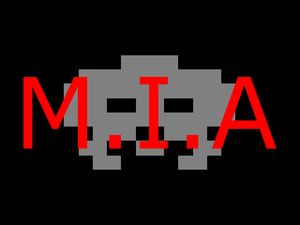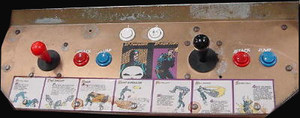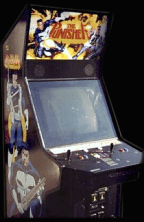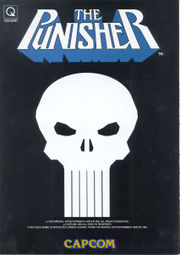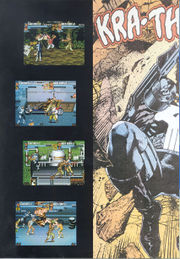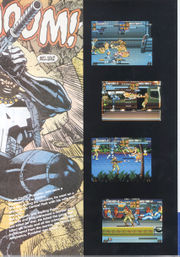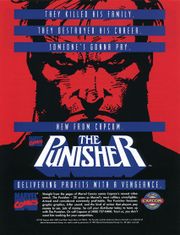Lost In Translation/Punisher, The
| The Punisher | |
|---|---|
| Manufacturer | Capcom |
| Released | 1993 |
| Control Method |
8-way Joystick 2 Button(s) |
| Main CPU | 68000 (@ 12.000 MHz) Z80 (@ 8.000 MHz) |
| Sound CPU | Stereo Q-Sound (@ 4.000 MHz) |
| Video Details |
Raster (Horizontal) 384 x 224 pixels 60.00 Hz 4,096 Palette colours |
| Screens | 1 |
| ROM Info | 22 ROMs 7,995,392 bytes (7.63 MiB) |
| MAME ID | punisher · punishrj · punishru |
About The Game
The Punisher is an horizontally scrolling arcade video game beat-em-up where you play as either The Punisher or Nick Fury, together or solo- and fight your way through many dangerous locales filled with criminals.
With lots of devastating weapons and moves to unleash on your opponents, you must find and defeat the Kingpin in game-play very similar to "Final Fight", also by Capcom.
Additional Technical Information
Players : 2
Control : 8-way joystick
Buttons : 2 (ATTACK, JUMP)
Trivia
Released in April 1993.
This game features the main characters from the comic books respectively titled 'The Punisher' (First appearance : Amazing Spider-Man 129, 1973) and 'Nick Fury' (First appearance : Sgt. Fury and his Howling Commandos 1, 1963), Agent of SHIELD, both published by Marvel Comics. The acronym SHIELD stands for 'Supreme Headquarters International Espionage Law-enforcement Division'.
Scully, the first of the boss villains here, is loosely based on a villain named Chester Scully who appeared in issues 22-23 (August and September, 1989) of the Punisher's first ongoing series, which ran from 1987 to 1995. The leaping kicks he uses in the game are an homage to the cover of the 23rd issue where his comic book counterpart is shown attacking the Punisher by kicking at him while jumping.
Hidden Bonus Level : Looking in the game source code, there's a hidden second bonus game in stage directory. It shows an aeroplane hijacking or something and two of the generic game thugs burst through the wind-shield. They run across the screen to the left and then punisher shows up. There are several stewardesses on the floor as hostages and when you go over to them they get freed. But then the stage like instantly is interrupted and randomly takes you to the score screen after every stage and says 'Stage 7 complete' and then switches to an alternate credits screen with all the enemies in the game running across and doing random things. It's probably a part of the game not completed and not remove from the final product and still present in the source code. The only way to see this hidden stage is to browse the source code or using a cheat with emulator like MAME.
Soundtrack releases :
Pony Canyon / Scitron - Tenchi wo Kurau II The Battle of Red Wall : G.S.M. Capcom 7 - PCCB-00133 - 20/08/1993.
Updates
The US version has the "Winners Don't Use Drugs" screen.
Japanese version is a bit different :
- The Super Kick results in blue flames on the enemy instead of blood.
Tips and tricks
- Super Kick : Down, Up+Attack
- Super AIR Kick : Forward(x2), Jump, Down+Attack
- Special Ending : finish the game without having to continue to see a different credit sequence (badguy parade).
- When you're in the 2nd area of stage 2, the gangsters' mansion in Florida, there are 3 jail cells in which 3 girls are being held hostage. Break open the cells and then stand still. The girls will give the players thank-you hugs that restore energy to their lifebars.
- The Punisher and Nick Fury's personal handguns are usually drawn automatically whenever enemies carrying firearms - and also the robots called 'Pretty Boy' - turn up. With the exception of the robots, which are tougher to deal with, try to refrain from killing the enemies armed with guns until after you've killed some of those who aren't carrying guns. This certainly comes in useful during the showdown at the end with the Kingpin, who's drawn much larger here than he was in Sega's own "Spider-Man - The Videogame", made 2 years earlier.
Staff
- Game Designers
- Akiman
- Maeda
- Buchi
- Jun Keiba
- Ohn
- Program Designers
- Kazuhito Nakai
- T. Ueno
- Y. Kawabata
- Mitsu
- Y. Mikami (ZZR)
- Character Designers
- Eripyon.N
- Matsunaga
- Mayo Seriya
- Daniel
- Vlad.T
- Inukichi
- Minobeyan
- Yokota Yokozo
- Koizumi
- Iwai
- Go
- T. Tathivana
- Mikiman
- Marilyn Higuchi
- Harusan
- Sound Designers
- Yoko Shimomura (Pi B)
- Isao Abe
- Toshio Kajino
- Syun Nishigaki
- Nobu. Oouchi
- Director
- Noritaka Funamizu (Poo)
- System Advice
- Jaboon
- Illustration Designer
- Sensei
Cabinet and Artwork
Ports
- Consoles
- Sega Mega Drive (1994)
Soundtrack Releases
| Album Name | Catalogue No. | Released | Publisher | Comments |
|---|---|---|---|---|
| Tenchi wo Kurau II: The Battle of Red Cliff -G.S.M. CAPCOM 7- | PCCB-00133[1] | 1993-08-20 | Pony Canyon, Inc. | 2 CD version. |



